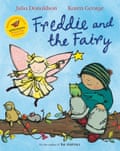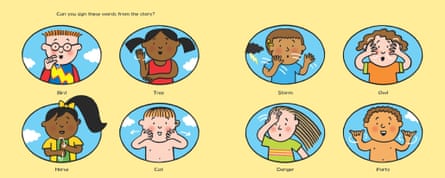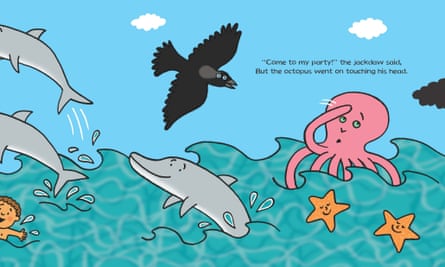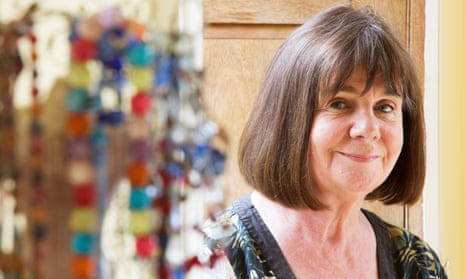What the Jackdaw Saw is the second book I have written (or in this case co-written) featuring deafness, illustrated by Nick Sharratt. The first one was Freddie and the Fairy, illustrated by Karen George. It’s the story of a hard-of-hearing fairy and a mumbling child. Because the child doesn’t speak clearly and covers his mouth with his hand, the fairy mishears his wishes and conjures up a frog instead of a dog, a carrot instead of a parrot, and so on.

I was very touched by the positive response to Freddie and the Fairy from deaf children, their parents and their teachers, and realised what a lot it meant to children with hearing problems, and in particular hearing aids, to see a character like themselves in a book. That was one of the reasons why, when I became the children’s laureate in 2011, I decided I would do all I could to promote stories for and about deaf children.

I knew that this would be a journey of discovery for me. Despite being hard of hearing myself and wearing hearing aids, I could not lip-read or sign and had only once or twice visited schools for the deaf. So I was a little apprehensive, although excited too, when the Life & Deaf Association asked if I could take part in a day-long workshop to help a group of deaf children produce a picture book.

Usually I write in isolation, and I didn’t know how this group activity would work out. We didn’t have to start completely from scratch, as the children and their teachers had already done some talking and planning. Having read my book What the Ladybird Heard (illustrated by Lydia Monks), they’d come up with the title What the Jackdaw Saw , which I thought was brilliant.
Jane Thomas - a gifted speech and language Therapist and one of the founders of Life & Deaf (with Katie Ford also a sign language teacher and Helena Ballard, a teacher of the deaf) – phoned to tell me some of their ideas for the storyline. I remember this conversation particularly vividly because I was in the bath at the time! The children had had the idea that the hearing jackdaw would be flying over Greenwich (which is where their schools were), trying to communicate with some deaf animals down below. The pictures would feature different Greenwich landmarks such as the Cutty Sark, the Maritime Museum, the power station and the O2 concert hall.
I loved the idea of the hearing jackdaw and the deaf animals, especially the ending which they had in mind – that the jackdaw would learn sign language. However, I did voice some doubts about the Greenwich setting, as I felt it would be great if the book could have a wider appeal and a greater variety of illustrations. I suggested to Jane (as the bathwater cooled) that the jackdaw might be flying over different countries, but she pointed out that not all countries used British sign language. So we discussed the idea of different landscapes, each one featuring different animals.
The day for the workshop arrived, and I was introduced to the children, the teachers, the Life & Deaf team, the interpreters and two illustrators, Bev Wilson and Becky Bailey. Bev was hearing and Becky deaf, but both were expert signers. The atmosphere was so enthusiastic that my slight anxiety melted away.

The children had already done some more work on the story, each one working on a different page. I really liked what they had done, but the trouble was that it was a bit disjointed, jumping from one rhyme scheme to another and with some pages not being in rhyme. I acted out The Gruffalo for them and used it as an example of a structured story in which each episode follows the same pattern and rhyme scheme.
I also felt that before going any further we needed to decide what the jackdaw was trying to say to the animals and what they were trying to sign to him. I can’t remember who came up with the idea of “come to my party” and “Danger!”, but for me that was when the story really took off and I could see it could be quite dramatic.
I suggested that we keep some of the initial ideas but that we should decide on a pattern for each page, with the rhyming parts all sticking to the same rhythm. We then divided the children into groups. Some of them sat at tables, working on the language for the different scenes of the book: seaside, farm, woodland and so on. Others worked with the illustrators, drawing the animals and landscapes on a frieze of paper which had been stuck on one of the walls.
Every now and then Jane convened everyone and used a flip chart to do a progress report. I was so grateful for her support – and for that of all the other adults – as I could never have managed to structure the day and hold the children’s attention single-handed. At one of these sessions, we all voted on which animals should be making the “danger” sign, and what colour they should all be.
For me the best part of the day was the end when the children acted out the story they had all helped to create. As Children’s Laureate I had been encouraging children to perform stories and poems, but I had rarely seen any do so with such panache as these ones.
When I asked Helena how many copies of the book they were planning to print, she told me that they couldn’t actually afford to print any, and that the book would only be available online. That was when I had the idea of approaching my publisher, Macmillan, to see if they might publish the book themselves. I warned the Life & Deaf team that it probably wouldn’t be possible to use the children’s own illustrations, since the book would need to be commercially viable and in practice books illustrated by children – specially by lots of different children – just don’t sell. Although this was a shame, Helena, Jane and Katie felt that the exercise had been partly to show the children what was involved in developing a germ of a story into a fully-fledged book.
I still felt concerned that the children who had worked mainly on the illustrations might feel under-represented, but at least their pictures could perhaps feature on the Life & Deaf website, and some of those children could act in the performance of the story at the ceremony when I handed over the Laureateship to Malorie Blackman in June 2013.
The next stage was for me to do some “tweaking” of the story and language, and for Macmillan to find an illustrator. I was delighted when they approached Nick Sharratt, for various reasons. He and I have often worked together (on books such as Toddle Waddle and – my favourite – Goat Goes to Playgroup. Nick’s illustrations are always so clear and witty and I’ve seen from my grandchildren’s reactions how appealing they are to children. And also he has always been committed to including deaf and disabled children in his pictures.
I hope my co-authors didn’t get too tired of waiting. As is often the case with picture books, it took two years between the delivery of the manuscript and publication of the book, and some of the “children” were now in their teens or had even left school. But it was wonderful to see them all again at the launch of the book, along with their enthusiastic families, where the highlight was the performance, which was even more stunning than before. Life & Deaf had arranged for some amazing feathered masks to be specially made, and the children mimed, signed and acted the story in such a professional way that at the end almost everyone was in tears. I’ve been to many a book launch, but never one as special as that.
To my mind What the Jackdaw Saw is such a dramatic, simple and yet unusual story that it should appeal strongly to all children, whether deaf or hearing. I certainly hope so, as I’d like as many hearing children to find out about signing as possible, and also for Life & Deaf to earn a nice lot of money from the royalties, so that they can carry on with their valuable work.
